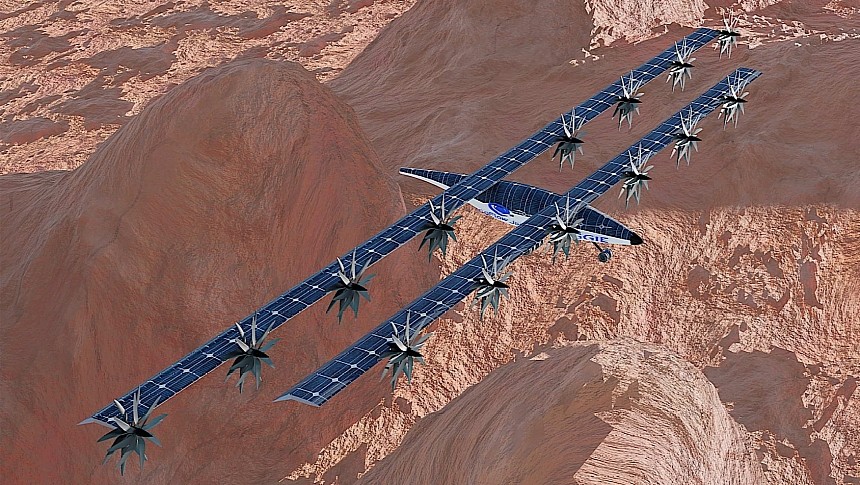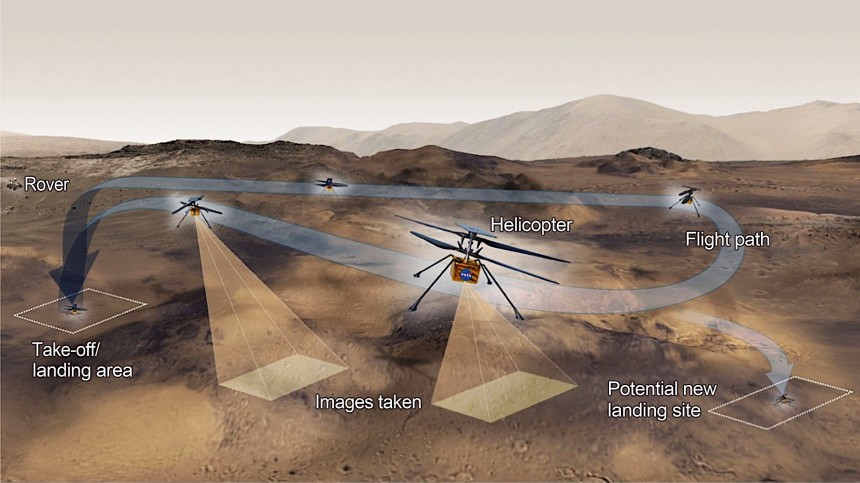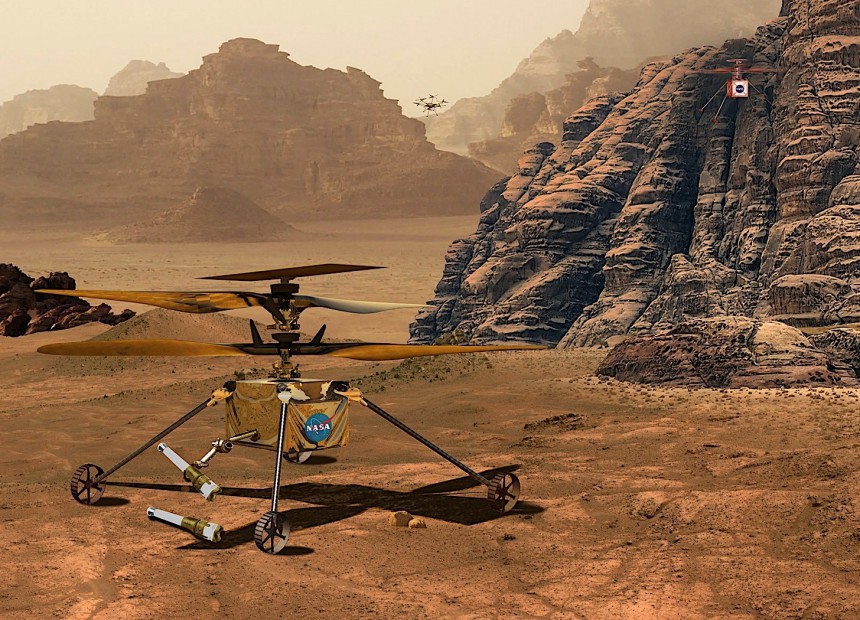Thanks to its relative proximity to our planet and the similarities it shares with Earth, Mars has always been a center of attention for our species. So much so that over the past decades we've sent tons of exploration missions there, more than on any other celestial body in this solar system – yes, even more than on the Moon.
Mars is at the receiving end of around 50 space missions, which came as orbiters, landers, and rovers. Many have failed, but others were so successful that they gave us, truly, an entirely new understanding of the place.
Each of these missions had its own particularities, and they were aimed at performing specific science. And they all contributed a little something to the completion of the Martian puzzle. But we're far from done with it yet.
You see, for all their merits all the missions sent so far to Mars have been limited in reach. The orbiters look down on the planet from high above, but they can only take in the alien world one slice at a time and from too high up to capture all the details we would want.
Landers are, as their name says, immobile, and although the science they can return is at times spectacular, they are very limited in terms of reach and scope.
Last but not least we have the rovers, the only pieces of technology that can move under their own power across the surface, and study from really, really close, different spots of the reddish soil. But they are slow, painfully so, and if you don't land them in just the right place, chances are you'll not find anything worth mentioning.
The newest rover to be sent up there is called Perseverance. It reached the planet in 2021 and set out to do what all other rovers before it did: sample Mars, either to analyze by itself, or to store away for a subsequent mission to arrive and bring the samples back to Earth.
But Perseverance carried with it something that may very well turn into a new way of exploring alien worlds, joining the arsenal of orbiters, landers, and rovers: an aircraft.
The aircraft is called Ingenuity, it is a helicopter-like machine by trade, and its mission ended back in January after an incident led to it breaking one of its rotor blades. But before doing that, Ingenuity revolutionized space exploration.
The mini-helo was sent to Mars to prove one thing and one thing only: that sustained, powered, and controlled flight is possible in the atmospheres of other worlds, including the ones as thin as over on the Red Planet: about 100 times less thickness than what one gets here on Earth.
Ingenuity was initially supposed to fly just five times over a span of 30 days, but it ended up being operational for almost three Earth years, and it conducted 72 flights. It traveled a total distance of 10.5 miles (17.0 km), 14 times farther than planned, helping us get a view of Mars from a vantage point that was inaccessible to us until now.
The success of the helicopter, as well as the promises in terms of new findings aerial reconnaissance brings with it, has prompted many thinkers around the world to try to come up with new ways of exploring places far from our own planet. One such idea comes from a company known as Coflow Jet and someone named Ge-Cheng Zha.
This crew is officially working on bringing "ultra-high lift, efficient and low noise technology to electric VTOL and STOL aircraft," but found that their idea can apply to aircraft meant for alien worlds as well.
Enter MAGGIE. That's an acronym, obviously, and it stands for Mars Aerial and Ground Intelligent Explorer. A fancy name that's meant to hide an aerial exploration platform that can move through the planet's sky and survey whatever lies beneath.
MAGGIE has been imagined as a fixed-wing aircraft that operates like a vertical take-off and landing machine. To make sure it stays airborne in the thin atmosphere, the aircraft uses a type of deflected slipstream tech called a co-flow jet.
In a nutshell, that is an active flow control method that relies on an airfoil system with injection and suction slots near the leading and trailing edges. It's meant to provide more lift for the wing, making it easier for the aircraft to take off, travel, and land.
MAGGIE is powered by solar power, with panels installed all over the upper side to capture as much sunlight as possible. The central body of the aircraft is supported by two sets of massive wings, with a total of eight propellers for the rear set and six for the front one.
The VTOL should be capable of traveling at speeds of 192 mph (309 kph), and will be able to climb to altitudes that are "an order of magnitude higher than conventional subsonic aircraft."
The batteries in the VTOL should give it a range of 111 miles (179 km) at 3,200 feet (1,000 meters). It means that in a whole Martian year MAGGIE will be able to travel a distance of 9,900 miles (16,000 km). That's far greater than any other piece of hardware ever sent inside the Martian atmosphere, and something with the potential to survey the entire Martian landscape in a relatively short time.
The tech has been devised with three main missions in mind: have a look at the planet's magnetic fields, determine the source of methane in the Gale crater, and map subsurface water.
It will do that only, and only if it ever gets made. For now the idea is just a concept, but one with enough merit to have earned it an Innovative Advanced Concepts (NIAC) program award from NASA at the beginning of the year.
It's unclear if and when a prototype of MAGGIE could be tested, but if it ever gets here it will probably revolutionize not only planetary exploration, but the development of Earth-bound VTOLs as well.
Each of these missions had its own particularities, and they were aimed at performing specific science. And they all contributed a little something to the completion of the Martian puzzle. But we're far from done with it yet.
You see, for all their merits all the missions sent so far to Mars have been limited in reach. The orbiters look down on the planet from high above, but they can only take in the alien world one slice at a time and from too high up to capture all the details we would want.
Landers are, as their name says, immobile, and although the science they can return is at times spectacular, they are very limited in terms of reach and scope.
Last but not least we have the rovers, the only pieces of technology that can move under their own power across the surface, and study from really, really close, different spots of the reddish soil. But they are slow, painfully so, and if you don't land them in just the right place, chances are you'll not find anything worth mentioning.
The newest rover to be sent up there is called Perseverance. It reached the planet in 2021 and set out to do what all other rovers before it did: sample Mars, either to analyze by itself, or to store away for a subsequent mission to arrive and bring the samples back to Earth.
But Perseverance carried with it something that may very well turn into a new way of exploring alien worlds, joining the arsenal of orbiters, landers, and rovers: an aircraft.
The mini-helo was sent to Mars to prove one thing and one thing only: that sustained, powered, and controlled flight is possible in the atmospheres of other worlds, including the ones as thin as over on the Red Planet: about 100 times less thickness than what one gets here on Earth.
Ingenuity was initially supposed to fly just five times over a span of 30 days, but it ended up being operational for almost three Earth years, and it conducted 72 flights. It traveled a total distance of 10.5 miles (17.0 km), 14 times farther than planned, helping us get a view of Mars from a vantage point that was inaccessible to us until now.
The success of the helicopter, as well as the promises in terms of new findings aerial reconnaissance brings with it, has prompted many thinkers around the world to try to come up with new ways of exploring places far from our own planet. One such idea comes from a company known as Coflow Jet and someone named Ge-Cheng Zha.
This crew is officially working on bringing "ultra-high lift, efficient and low noise technology to electric VTOL and STOL aircraft," but found that their idea can apply to aircraft meant for alien worlds as well.
Enter MAGGIE. That's an acronym, obviously, and it stands for Mars Aerial and Ground Intelligent Explorer. A fancy name that's meant to hide an aerial exploration platform that can move through the planet's sky and survey whatever lies beneath.
MAGGIE has been imagined as a fixed-wing aircraft that operates like a vertical take-off and landing machine. To make sure it stays airborne in the thin atmosphere, the aircraft uses a type of deflected slipstream tech called a co-flow jet.
MAGGIE is powered by solar power, with panels installed all over the upper side to capture as much sunlight as possible. The central body of the aircraft is supported by two sets of massive wings, with a total of eight propellers for the rear set and six for the front one.
The VTOL should be capable of traveling at speeds of 192 mph (309 kph), and will be able to climb to altitudes that are "an order of magnitude higher than conventional subsonic aircraft."
The batteries in the VTOL should give it a range of 111 miles (179 km) at 3,200 feet (1,000 meters). It means that in a whole Martian year MAGGIE will be able to travel a distance of 9,900 miles (16,000 km). That's far greater than any other piece of hardware ever sent inside the Martian atmosphere, and something with the potential to survey the entire Martian landscape in a relatively short time.
The tech has been devised with three main missions in mind: have a look at the planet's magnetic fields, determine the source of methane in the Gale crater, and map subsurface water.
It will do that only, and only if it ever gets made. For now the idea is just a concept, but one with enough merit to have earned it an Innovative Advanced Concepts (NIAC) program award from NASA at the beginning of the year.
It's unclear if and when a prototype of MAGGIE could be tested, but if it ever gets here it will probably revolutionize not only planetary exploration, but the development of Earth-bound VTOLs as well.









